Investment Opportunity Evaluation: A Report for Pinto Limited
VerifiedAdded on 2023/06/12
|6
|1345
|370
Report
AI Summary
This report presents a comprehensive financial evaluation of a new investment opportunity for Pinto Limited. It employs various capital budgeting tools, including Net Present Value (NPV), Payback Period, Discounted Payback Period, Profitability Index, and Internal Rate of Return (IRR), to assess the project's profitability. The base case analysis indicates a positive NPV of $5.6 million and a payback period of 2.73 years, suggesting the project is financially viable. Uncertainty analysis, including sensitivity and scenario analysis, is conducted to address potential risks. Sensitivity analysis reveals the project's high sensitivity to changes in units sold. Scenario analysis projects outcomes under positive, neutral, and negative scenarios. The report concludes that the project is expected to generate a positive NPV and recommends that Pinto Limited accept the proposal, as it is likely to be profitable.

Finance
Paraphrase This Document
Need a fresh take? Get an instant paraphrase of this document with our AI Paraphraser
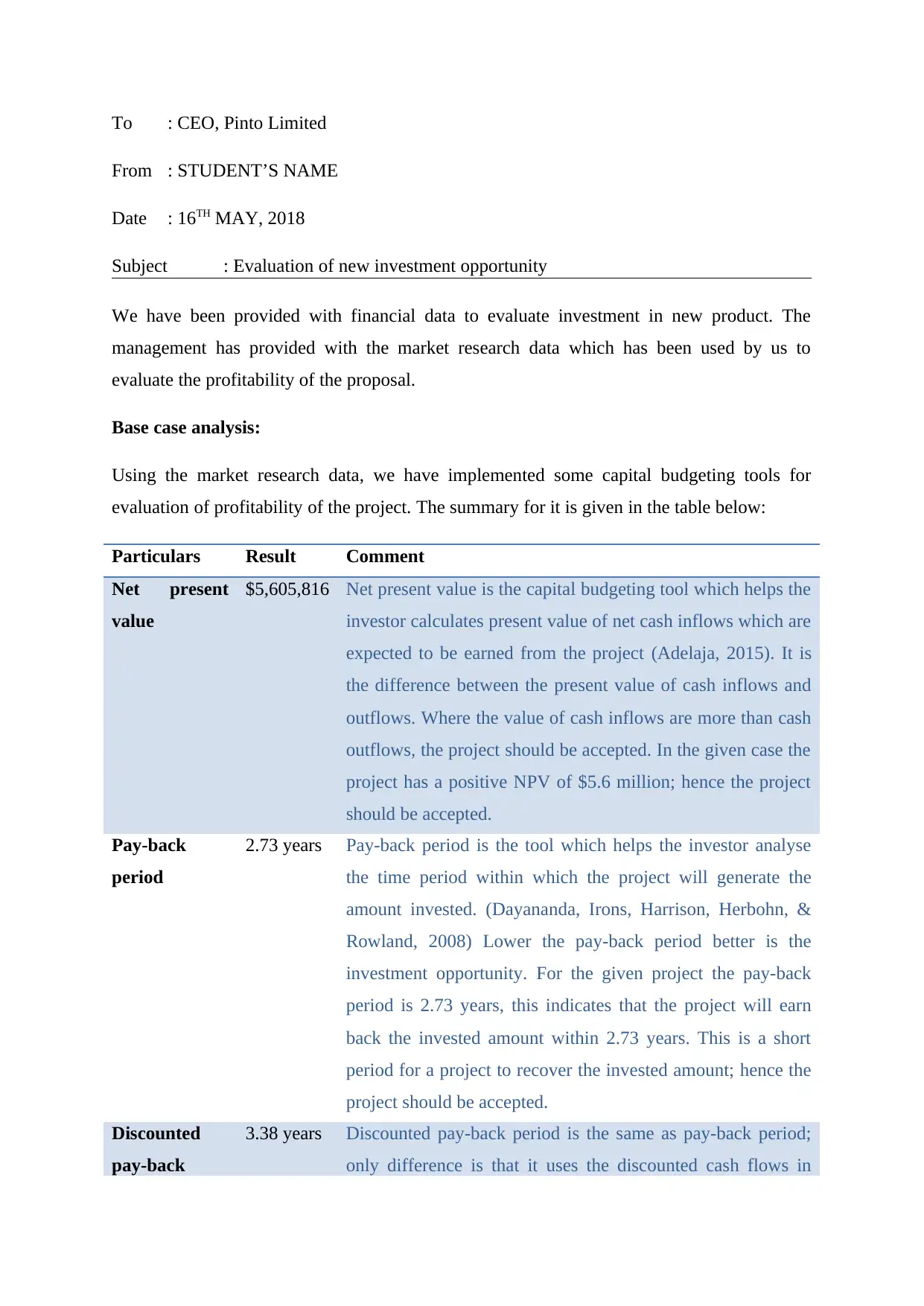
To : CEO, Pinto Limited
From : STUDENT’S NAME
Date : 16TH MAY, 2018
Subject : Evaluation of new investment opportunity
We have been provided with financial data to evaluate investment in new product. The
management has provided with the market research data which has been used by us to
evaluate the profitability of the proposal.
Base case analysis:
Using the market research data, we have implemented some capital budgeting tools for
evaluation of profitability of the project. The summary for it is given in the table below:
Particulars Result Comment
Net present
value
$5,605,816 Net present value is the capital budgeting tool which helps the
investor calculates present value of net cash inflows which are
expected to be earned from the project (Adelaja, 2015). It is
the difference between the present value of cash inflows and
outflows. Where the value of cash inflows are more than cash
outflows, the project should be accepted. In the given case the
project has a positive NPV of $5.6 million; hence the project
should be accepted.
Pay-back
period
2.73 years Pay-back period is the tool which helps the investor analyse
the time period within which the project will generate the
amount invested. (Dayananda, Irons, Harrison, Herbohn, &
Rowland, 2008) Lower the pay-back period better is the
investment opportunity. For the given project the pay-back
period is 2.73 years, this indicates that the project will earn
back the invested amount within 2.73 years. This is a short
period for a project to recover the invested amount; hence the
project should be accepted.
Discounted
pay-back
3.38 years Discounted pay-back period is the same as pay-back period;
only difference is that it uses the discounted cash flows in
From : STUDENT’S NAME
Date : 16TH MAY, 2018
Subject : Evaluation of new investment opportunity
We have been provided with financial data to evaluate investment in new product. The
management has provided with the market research data which has been used by us to
evaluate the profitability of the proposal.
Base case analysis:
Using the market research data, we have implemented some capital budgeting tools for
evaluation of profitability of the project. The summary for it is given in the table below:
Particulars Result Comment
Net present
value
$5,605,816 Net present value is the capital budgeting tool which helps the
investor calculates present value of net cash inflows which are
expected to be earned from the project (Adelaja, 2015). It is
the difference between the present value of cash inflows and
outflows. Where the value of cash inflows are more than cash
outflows, the project should be accepted. In the given case the
project has a positive NPV of $5.6 million; hence the project
should be accepted.
Pay-back
period
2.73 years Pay-back period is the tool which helps the investor analyse
the time period within which the project will generate the
amount invested. (Dayananda, Irons, Harrison, Herbohn, &
Rowland, 2008) Lower the pay-back period better is the
investment opportunity. For the given project the pay-back
period is 2.73 years, this indicates that the project will earn
back the invested amount within 2.73 years. This is a short
period for a project to recover the invested amount; hence the
project should be accepted.
Discounted
pay-back
3.38 years Discounted pay-back period is the same as pay-back period;
only difference is that it uses the discounted cash flows in
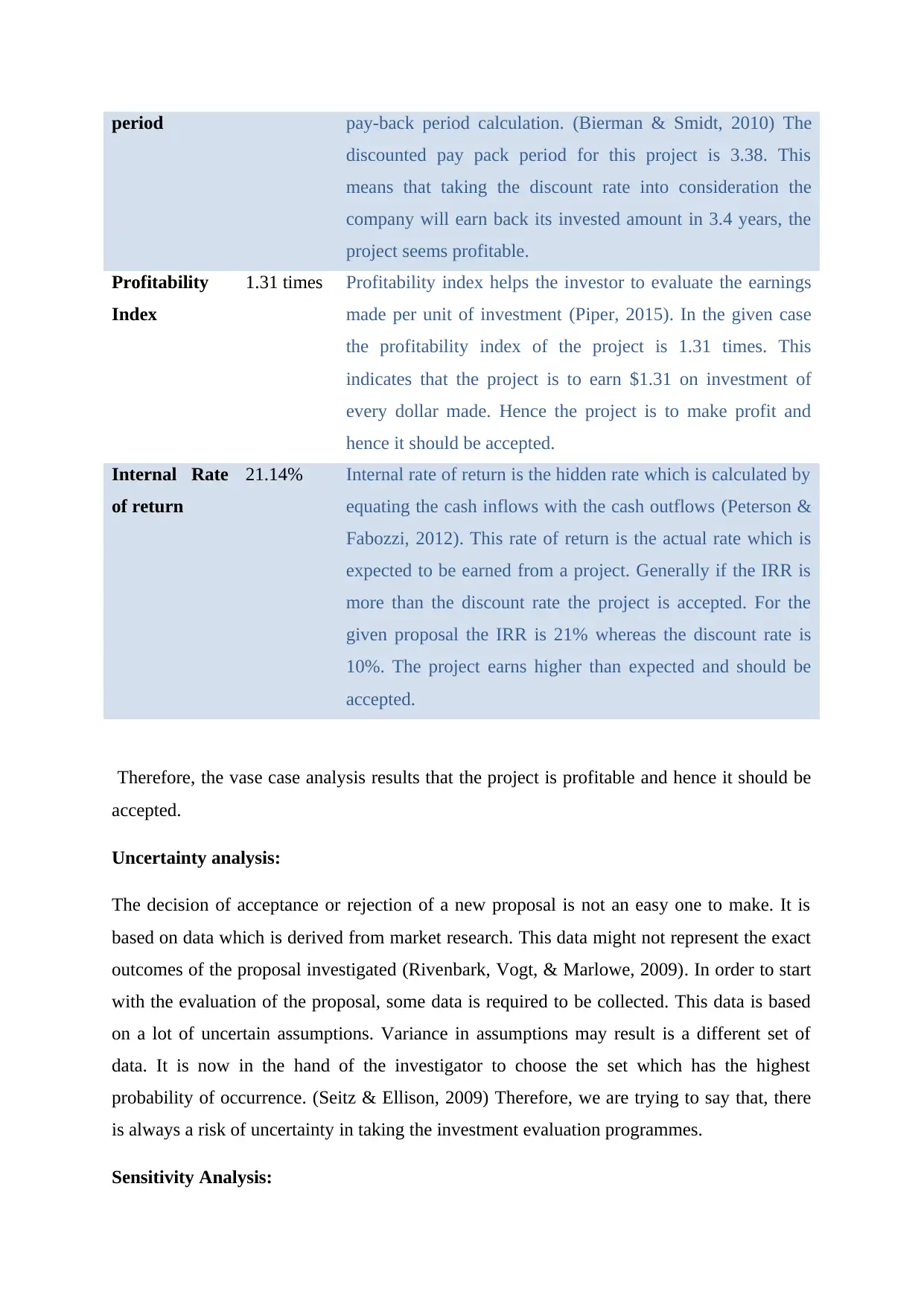
period pay-back period calculation. (Bierman & Smidt, 2010) The
discounted pay pack period for this project is 3.38. This
means that taking the discount rate into consideration the
company will earn back its invested amount in 3.4 years, the
project seems profitable.
Profitability
Index
1.31 times Profitability index helps the investor to evaluate the earnings
made per unit of investment (Piper, 2015). In the given case
the profitability index of the project is 1.31 times. This
indicates that the project is to earn $1.31 on investment of
every dollar made. Hence the project is to make profit and
hence it should be accepted.
Internal Rate
of return
21.14% Internal rate of return is the hidden rate which is calculated by
equating the cash inflows with the cash outflows (Peterson &
Fabozzi, 2012). This rate of return is the actual rate which is
expected to be earned from a project. Generally if the IRR is
more than the discount rate the project is accepted. For the
given proposal the IRR is 21% whereas the discount rate is
10%. The project earns higher than expected and should be
accepted.
Therefore, the vase case analysis results that the project is profitable and hence it should be
accepted.
Uncertainty analysis:
The decision of acceptance or rejection of a new proposal is not an easy one to make. It is
based on data which is derived from market research. This data might not represent the exact
outcomes of the proposal investigated (Rivenbark, Vogt, & Marlowe, 2009). In order to start
with the evaluation of the proposal, some data is required to be collected. This data is based
on a lot of uncertain assumptions. Variance in assumptions may result is a different set of
data. It is now in the hand of the investigator to choose the set which has the highest
probability of occurrence. (Seitz & Ellison, 2009) Therefore, we are trying to say that, there
is always a risk of uncertainty in taking the investment evaluation programmes.
Sensitivity Analysis:
discounted pay pack period for this project is 3.38. This
means that taking the discount rate into consideration the
company will earn back its invested amount in 3.4 years, the
project seems profitable.
Profitability
Index
1.31 times Profitability index helps the investor to evaluate the earnings
made per unit of investment (Piper, 2015). In the given case
the profitability index of the project is 1.31 times. This
indicates that the project is to earn $1.31 on investment of
every dollar made. Hence the project is to make profit and
hence it should be accepted.
Internal Rate
of return
21.14% Internal rate of return is the hidden rate which is calculated by
equating the cash inflows with the cash outflows (Peterson &
Fabozzi, 2012). This rate of return is the actual rate which is
expected to be earned from a project. Generally if the IRR is
more than the discount rate the project is accepted. For the
given proposal the IRR is 21% whereas the discount rate is
10%. The project earns higher than expected and should be
accepted.
Therefore, the vase case analysis results that the project is profitable and hence it should be
accepted.
Uncertainty analysis:
The decision of acceptance or rejection of a new proposal is not an easy one to make. It is
based on data which is derived from market research. This data might not represent the exact
outcomes of the proposal investigated (Rivenbark, Vogt, & Marlowe, 2009). In order to start
with the evaluation of the proposal, some data is required to be collected. This data is based
on a lot of uncertain assumptions. Variance in assumptions may result is a different set of
data. It is now in the hand of the investigator to choose the set which has the highest
probability of occurrence. (Seitz & Ellison, 2009) Therefore, we are trying to say that, there
is always a risk of uncertainty in taking the investment evaluation programmes.
Sensitivity Analysis:
⊘ This is a preview!⊘
Do you want full access?
Subscribe today to unlock all pages.

Trusted by 1+ million students worldwide
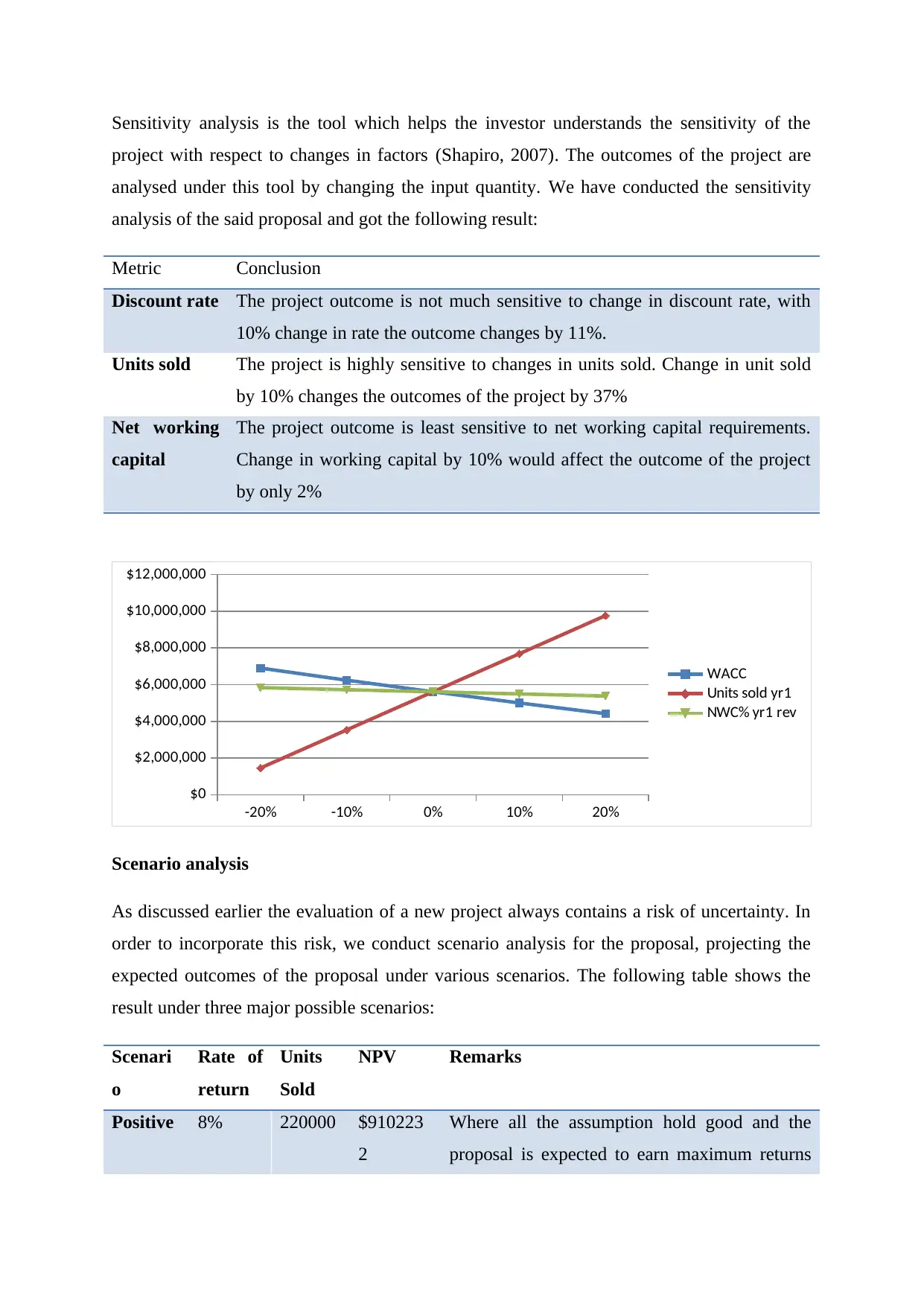
Sensitivity analysis is the tool which helps the investor understands the sensitivity of the
project with respect to changes in factors (Shapiro, 2007). The outcomes of the project are
analysed under this tool by changing the input quantity. We have conducted the sensitivity
analysis of the said proposal and got the following result:
Metric Conclusion
Discount rate The project outcome is not much sensitive to change in discount rate, with
10% change in rate the outcome changes by 11%.
Units sold The project is highly sensitive to changes in units sold. Change in unit sold
by 10% changes the outcomes of the project by 37%
Net working
capital
The project outcome is least sensitive to net working capital requirements.
Change in working capital by 10% would affect the outcome of the project
by only 2%
-20% -10% 0% 10% 20%
$0
$2,000,000
$4,000,000
$6,000,000
$8,000,000
$10,000,000
$12,000,000
WACC
Units sold yr1
NWC% yr1 rev
Scenario analysis
As discussed earlier the evaluation of a new project always contains a risk of uncertainty. In
order to incorporate this risk, we conduct scenario analysis for the proposal, projecting the
expected outcomes of the proposal under various scenarios. The following table shows the
result under three major possible scenarios:
Scenari
o
Rate of
return
Units
Sold
NPV Remarks
Positive 8% 220000 $910223
2
Where all the assumption hold good and the
proposal is expected to earn maximum returns
project with respect to changes in factors (Shapiro, 2007). The outcomes of the project are
analysed under this tool by changing the input quantity. We have conducted the sensitivity
analysis of the said proposal and got the following result:
Metric Conclusion
Discount rate The project outcome is not much sensitive to change in discount rate, with
10% change in rate the outcome changes by 11%.
Units sold The project is highly sensitive to changes in units sold. Change in unit sold
by 10% changes the outcomes of the project by 37%
Net working
capital
The project outcome is least sensitive to net working capital requirements.
Change in working capital by 10% would affect the outcome of the project
by only 2%
-20% -10% 0% 10% 20%
$0
$2,000,000
$4,000,000
$6,000,000
$8,000,000
$10,000,000
$12,000,000
WACC
Units sold yr1
NWC% yr1 rev
Scenario analysis
As discussed earlier the evaluation of a new project always contains a risk of uncertainty. In
order to incorporate this risk, we conduct scenario analysis for the proposal, projecting the
expected outcomes of the proposal under various scenarios. The following table shows the
result under three major possible scenarios:
Scenari
o
Rate of
return
Units
Sold
NPV Remarks
Positive 8% 220000 $910223
2
Where all the assumption hold good and the
proposal is expected to earn maximum returns
Paraphrase This Document
Need a fresh take? Get an instant paraphrase of this document with our AI Paraphraser
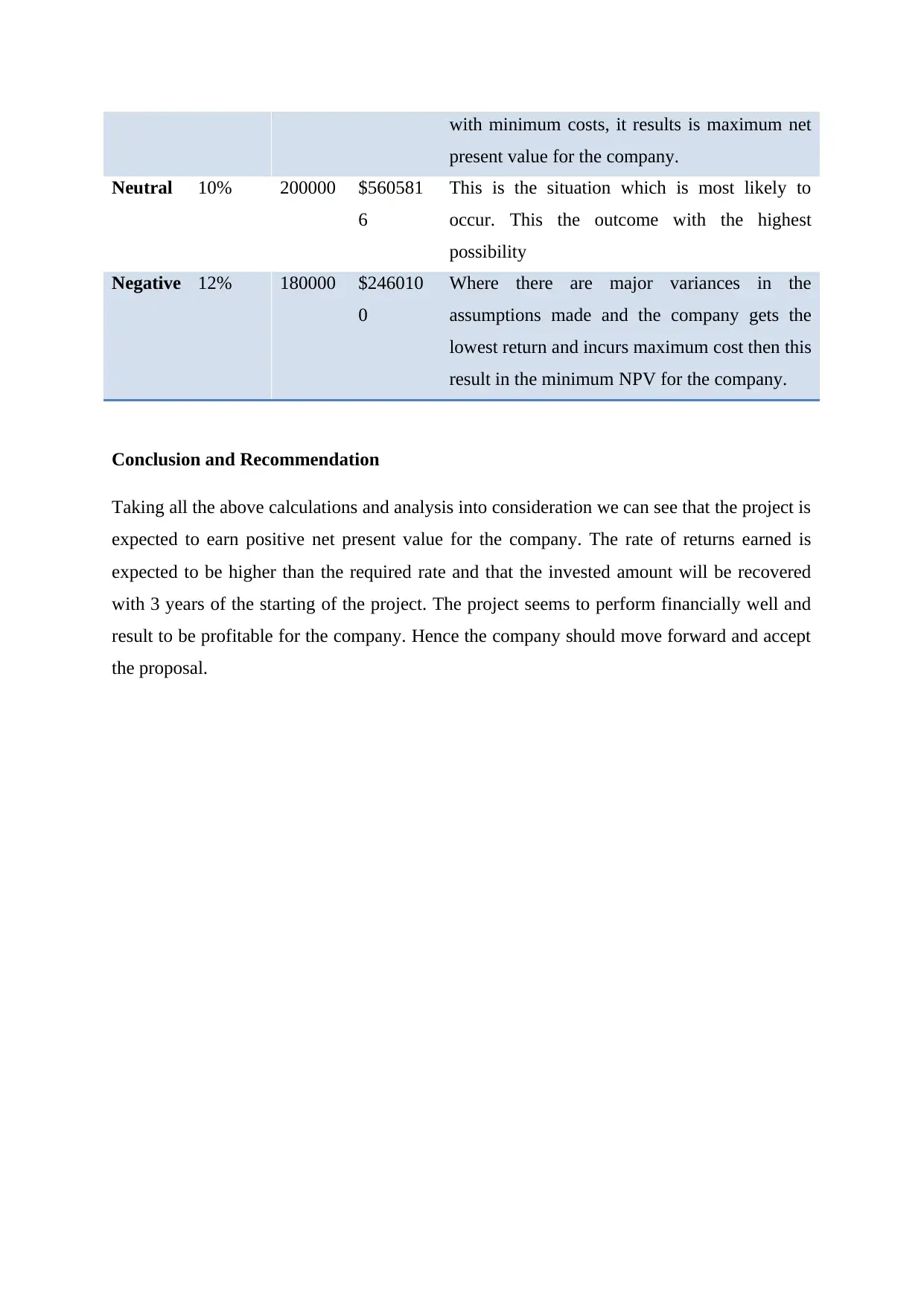
with minimum costs, it results is maximum net
present value for the company.
Neutral 10% 200000 $560581
6
This is the situation which is most likely to
occur. This the outcome with the highest
possibility
Negative 12% 180000 $246010
0
Where there are major variances in the
assumptions made and the company gets the
lowest return and incurs maximum cost then this
result in the minimum NPV for the company.
Conclusion and Recommendation
Taking all the above calculations and analysis into consideration we can see that the project is
expected to earn positive net present value for the company. The rate of returns earned is
expected to be higher than the required rate and that the invested amount will be recovered
with 3 years of the starting of the project. The project seems to perform financially well and
result to be profitable for the company. Hence the company should move forward and accept
the proposal.
present value for the company.
Neutral 10% 200000 $560581
6
This is the situation which is most likely to
occur. This the outcome with the highest
possibility
Negative 12% 180000 $246010
0
Where there are major variances in the
assumptions made and the company gets the
lowest return and incurs maximum cost then this
result in the minimum NPV for the company.
Conclusion and Recommendation
Taking all the above calculations and analysis into consideration we can see that the project is
expected to earn positive net present value for the company. The rate of returns earned is
expected to be higher than the required rate and that the invested amount will be recovered
with 3 years of the starting of the project. The project seems to perform financially well and
result to be profitable for the company. Hence the company should move forward and accept
the proposal.
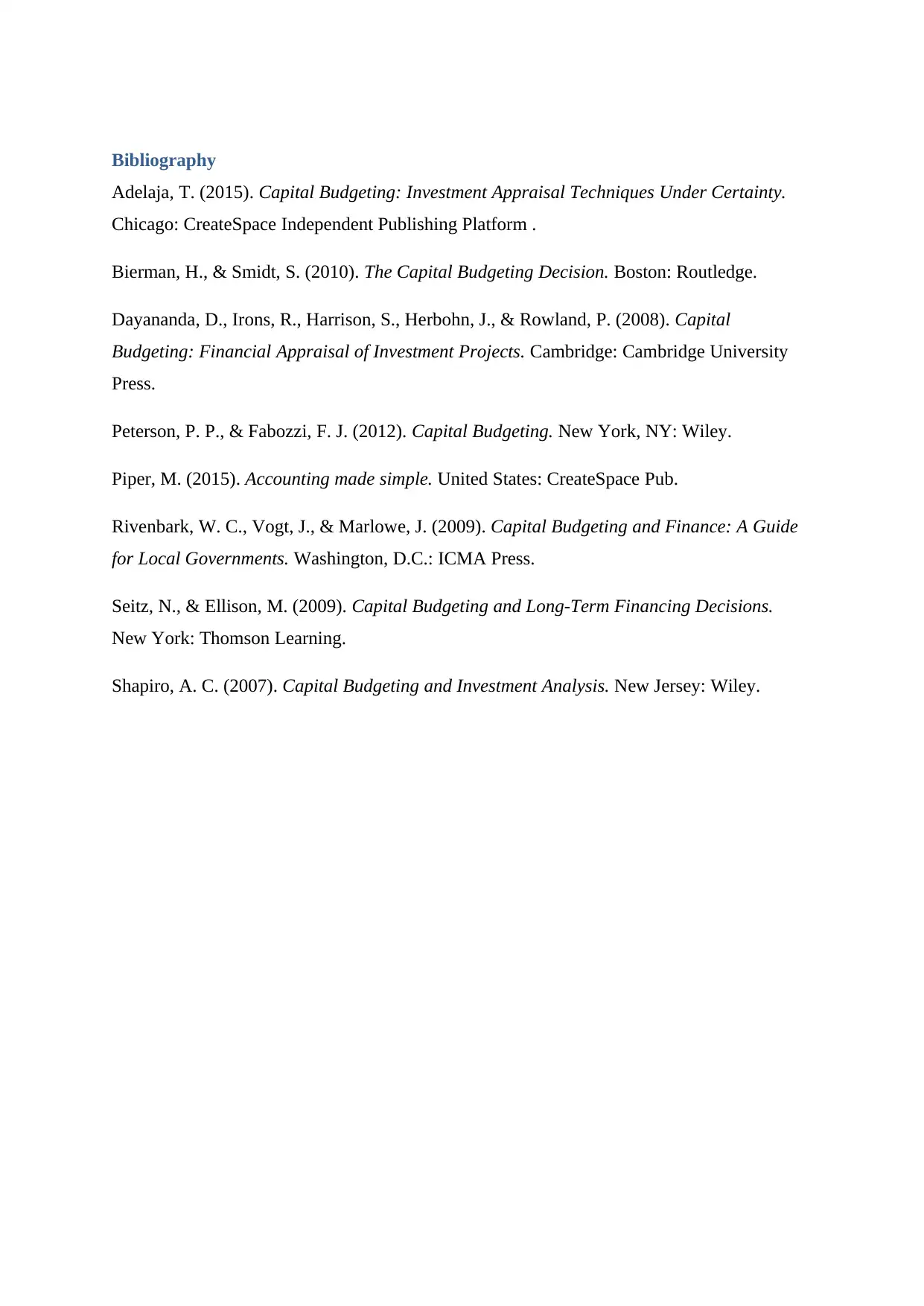
Bibliography
Adelaja, T. (2015). Capital Budgeting: Investment Appraisal Techniques Under Certainty.
Chicago: CreateSpace Independent Publishing Platform .
Bierman, H., & Smidt, S. (2010). The Capital Budgeting Decision. Boston: Routledge.
Dayananda, D., Irons, R., Harrison, S., Herbohn, J., & Rowland, P. (2008). Capital
Budgeting: Financial Appraisal of Investment Projects. Cambridge: Cambridge University
Press.
Peterson, P. P., & Fabozzi, F. J. (2012). Capital Budgeting. New York, NY: Wiley.
Piper, M. (2015). Accounting made simple. United States: CreateSpace Pub.
Rivenbark, W. C., Vogt, J., & Marlowe, J. (2009). Capital Budgeting and Finance: A Guide
for Local Governments. Washington, D.C.: ICMA Press.
Seitz, N., & Ellison, M. (2009). Capital Budgeting and Long-Term Financing Decisions.
New York: Thomson Learning.
Shapiro, A. C. (2007). Capital Budgeting and Investment Analysis. New Jersey: Wiley.
Adelaja, T. (2015). Capital Budgeting: Investment Appraisal Techniques Under Certainty.
Chicago: CreateSpace Independent Publishing Platform .
Bierman, H., & Smidt, S. (2010). The Capital Budgeting Decision. Boston: Routledge.
Dayananda, D., Irons, R., Harrison, S., Herbohn, J., & Rowland, P. (2008). Capital
Budgeting: Financial Appraisal of Investment Projects. Cambridge: Cambridge University
Press.
Peterson, P. P., & Fabozzi, F. J. (2012). Capital Budgeting. New York, NY: Wiley.
Piper, M. (2015). Accounting made simple. United States: CreateSpace Pub.
Rivenbark, W. C., Vogt, J., & Marlowe, J. (2009). Capital Budgeting and Finance: A Guide
for Local Governments. Washington, D.C.: ICMA Press.
Seitz, N., & Ellison, M. (2009). Capital Budgeting and Long-Term Financing Decisions.
New York: Thomson Learning.
Shapiro, A. C. (2007). Capital Budgeting and Investment Analysis. New Jersey: Wiley.
⊘ This is a preview!⊘
Do you want full access?
Subscribe today to unlock all pages.

Trusted by 1+ million students worldwide
1 out of 6
Related Documents
Your All-in-One AI-Powered Toolkit for Academic Success.
+13062052269
info@desklib.com
Available 24*7 on WhatsApp / Email
![[object Object]](/_next/static/media/star-bottom.7253800d.svg)
Unlock your academic potential
Copyright © 2020–2025 A2Z Services. All Rights Reserved. Developed and managed by ZUCOL.




